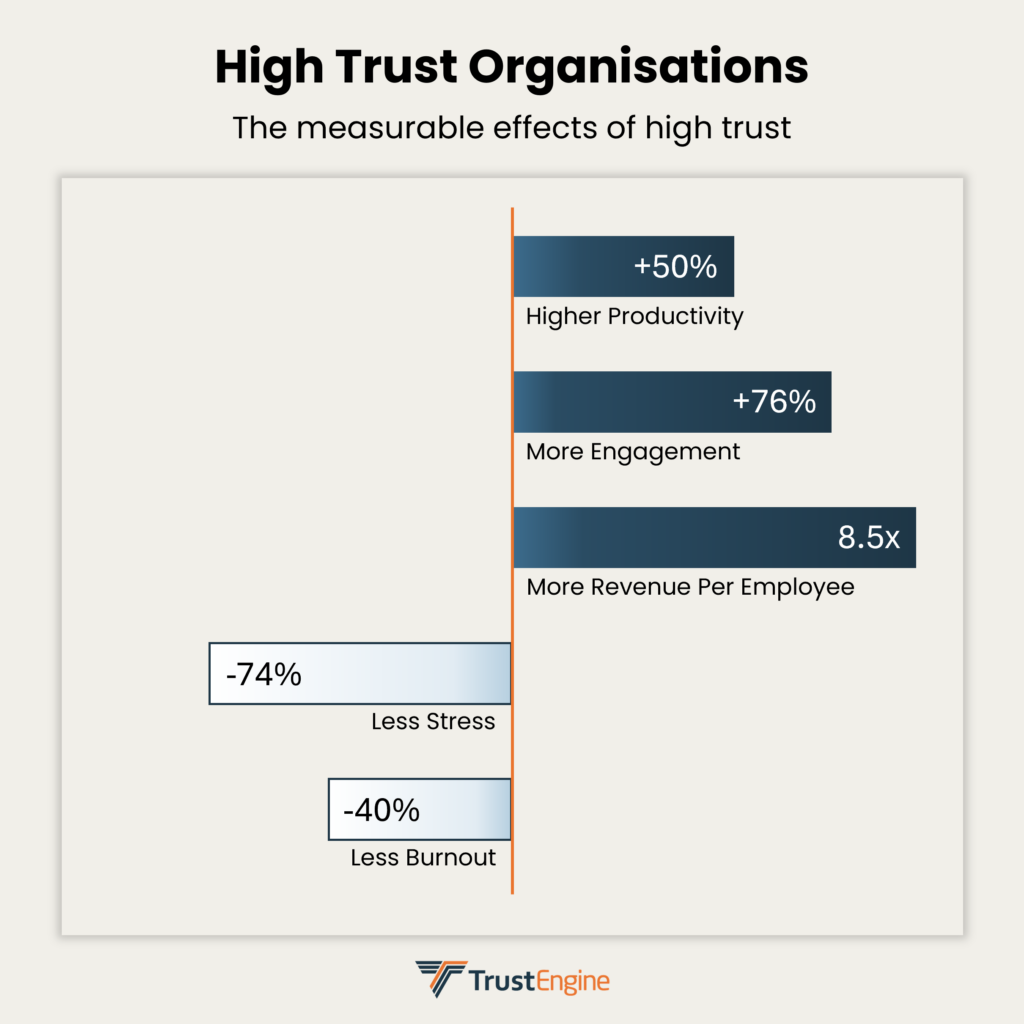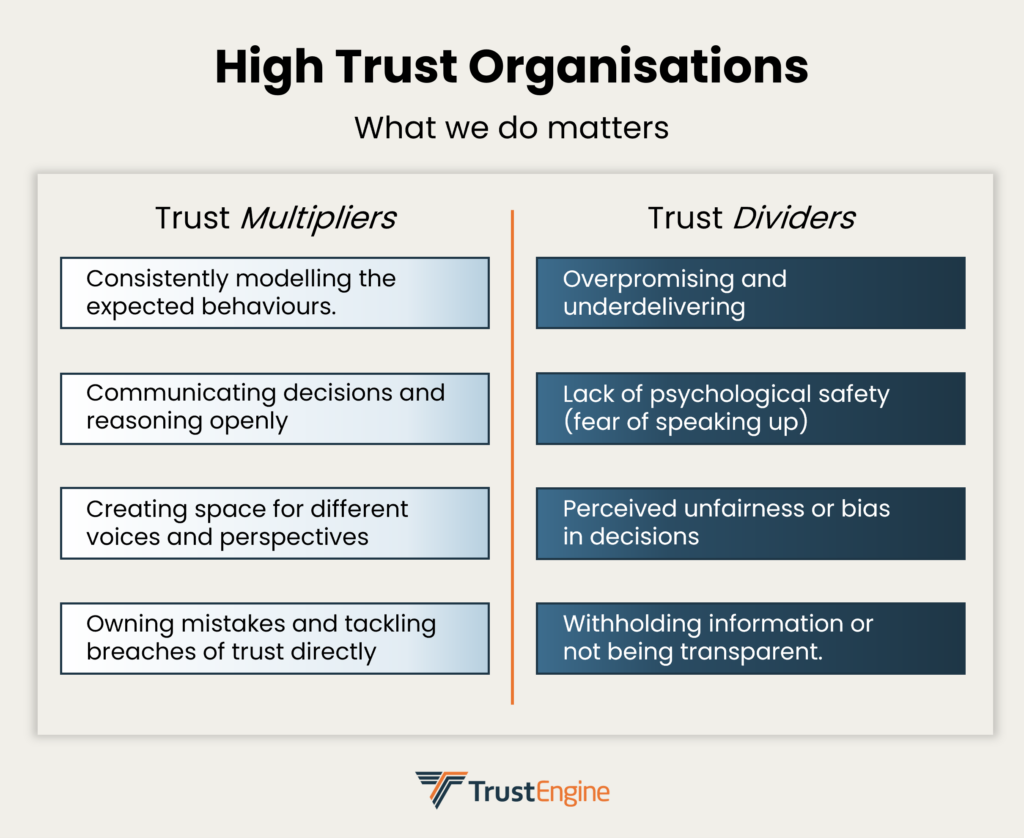Summary (TL;DR!)
- Trust is a performance multiplier for teams and organisations – linked to productivity, engagement, and financial outperformance. (Great Place to Work)
- Managers matter disproportionately: roughly 70% of team engagement variance traces back to the manager.
- The biggest blind spot? Leaders often overestimate employee trust, closing the perception gap requires visible actions and clear measures. (PwC)
- Grab the free Trust Playbook for ready-to-use templates (working agreement, say–do tracker, recognition plan, pulse survey): Download.

Final thought up front
Trust isn’t ‘soft’ – it’s operational excellence you can feel. Start with who best works with who, ensure clarity, make reliability visible, celebrate the right moments, and measure what matters. Leaders who do these consistently don’t just get happier teams—they get better results, faster. And the data backs you up.
Why trust is the quiet engine of team performance
When trust is high, it shows up in the metrics you’re held to: throughput, schedule reliability, quality, and people stability. Employees in high-trust cultures report +50% productivity, +76% engagement, −74% stress, −40% burnout, and 13% fewer sick days – all levers for on-time delivery, fewer defects, and steadier capacity. Pair that with the well-established manager effect (roughly 70% of engagement variance sits with the manager), and trust becomes a day-to-day management system: clearer decisions → faster handoffs → fewer surprises → better results. (Harvard Business Review)
In high-hazard operations like in resources and mining, psychological safety isn’t “buzz word” – it’s a risk control that drives culture (speaking up about hazards, reporting near misses) and better HSE outcomes. Research in the offshore oil-rig sector links stronger safety voice with lower perceived risk and fewer personal injuries; safety climate and leadership behaviours shape whether people report early or stay silent. When people can surface risks, ask naïve questions, and admit mistakes without fear, teams learn faster and deliver more. (Speaking up about safety concerns in high-risk industries: Correlates of safety voice in the offshore oil rig sector)
A note on team trust (not just “culture”)
Team-level trust is hyper-local. Two squads in the same company can feel totally different because micro-behaviours (how feedback is given, how decisions are recorded, whether leaders admit uncertainty) are what people live every day. That’s why the manager effect is so large and why simple, visible rituals (working agreements, decision logs, regular demos, clear handoffs) matter more than broad slogans
Organisational Trust Statistics
- Managers drive engagement: ~70% of the variance in team engagement is down to the manager.
- Global engagement is low: only ~23% of employees worldwide are engaged, an opportunity for leaders who get trust right. (Gallup)
- Perception gap: 86% of executives say they highly trust employees, but only 60% of employees feel highly trusted by leaders. And while 86% of execs think employee trust in the company is high, only 67% of employees agree. (PwC)

What leaders can try right away (practical, low effort – high impact moves)
- Put trust “on paper” with a one-page Working Agreement/Charter. Codify how decisions get made, where they’re recorded, feedback norms, and escalation paths. This reduces ambiguity (a trust killer) and speeds handoffs. Use the template in the Trust Playbook.
- Track the team’s “say–do ratio”. Create a simple log of commitments, owners, and due dates; review weekly. Reliability is trust’s backbone, aim for ≥0.85 completed commitments each week. This goes beyond an action list by highlighting and delivering on commitments publicly.
- Make expertise and help visible. New teams grant “swift trust” based on early cues about capability. Publish an Expertise & Help Map so everyone knows who to ask for what, what each person is learning, and their preferred communication style.
- Recognize trust-building behaviours – specifically. Shout out when someone calls a risk early, shares credit, or delivers a clean handoff. Consistently rewarding these moments makes the culture self-reinforcing. ‘Planned spontaneous recognition’ builds this into your leadership rhythm.
- Normalise constructive dissent and de-risk “bad news”. Open meetings with: “What could we be wrong about?” Call on two voices you haven’t heard. When someone surfaces a risk, thank them, act, and report back. The act of reporting back is as important as taking the feedback.
Signs your trust levels are slipping (and what to watch)
- Escalation latency increases: Issues surface late or sideways.
- Silent meetings, loud backchannels: Debate shifts to DMs; decisions become opaque.
- Commitments slip without renegotiation: The “say–do ratio” trends down.
- Credit asymmetry: The same few people get praised; cross-team favours go unreciprocated.
- Onboarding opacity: New joiners can’t explain team purpose, decision rights, or where decisions live after week one.
Free resource: Trust Playbook
TrustEngine have packaged some easy to use and practical templates that help create a trust strategy in your organisation or team. Use whatever suits your specific circumstances – but be consistent! Many teams suffer from ‘initiative fatigue’ by many (often competing) initiatives vying for attention. Making trust multiplying actions part of the way your team works helps set expectations that you can hold yourself and team accountable to.
Where a hyper focused tool can help: TrustEngine
While specific practices build trust, who you put together matters too. TrustEngine helps leaders purposefully match people – balancing skills, working styles, and values to predict and accelerate trust from day one. It complements the playbook by designing teams with fewer fault lines and more natural collaboration pathways.
